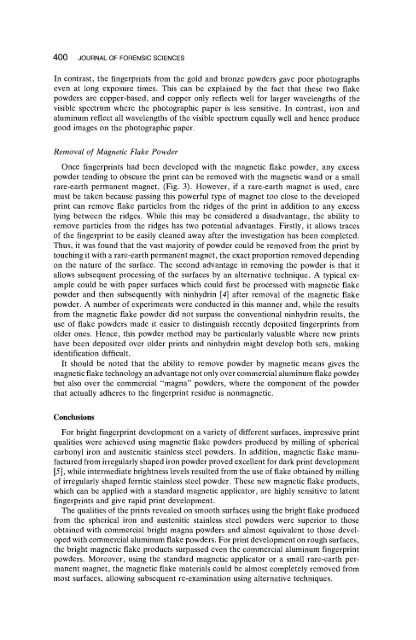Magnetic Flake Powders for Fingerprint Development - Library
Magnetic Flake Powders for Fingerprint Development - Library
Magnetic Flake Powders for Fingerprint Development - Library
You also want an ePaper? Increase the reach of your titles
YUMPU automatically turns print PDFs into web optimized ePapers that Google loves.
400 JOURNAL OF FORENSIC SCIENCES<br />
In contrast, the fingerprints from the gold and bronze powders gave poor photographs<br />
even at long exposure times. This can be explained by the fact that these two flake<br />
powders are copper-based, and copper only reflects well <strong>for</strong> larger wavelengths of the<br />
visible spectrum where the photographic paper is less sensitive. In contrast, iron and<br />
aluminum reflect all wavelengths of the visible spectrum equally well and hence produce<br />
good images on the photographic paper.<br />
Removal of <strong>Magnetic</strong> <strong>Flake</strong> Powder<br />
Once fingerprints had been developed with the magnetic flake powder, any excess<br />
powder tending to obscure the print can be removed with the magnetic wand or a small<br />
rare-earth permanent magnet, (Fig. 3). However, if a rare-earth magnet is used, care<br />
must be taken because passing this powerful type of magnet too close to the developed<br />
print can remove flake particles from the ridges of the print in addition to any excess<br />
lying between the ridges. While this may be considered a disadvantage, the ability to<br />
remove particles from the ridges has two potential advantages. Firstly, it allows traces<br />
of the fingerprint to be easily cleaned away after the investigation has been completed.<br />
Thus, it was found that the vast majority of powder could be removed from the print by<br />
touching it with a rare-earth permanent magnet, the exact proportion removed depending<br />
on the nature of the surface. The second advantage in removing the powder is that it<br />
allows subsequent processing of the surfaces by an alternative technique. A typical ex-<br />
ample could be with paper surfaces which could first be processed with magnetic flake<br />
powder and then subsequently with ninhydrin [4] after removal of the magnetic flake<br />
powder. A number of experiments were conducted in this manner and, while the results<br />
from the magnetic flake powder did not surpass the conventional ninhydrin results, the<br />
use of flake powders made it easier to distinguish recently deposited fingerprints from<br />
older ones. Hence, this powder method may be particularly valuable where new prints<br />
have been deposited over older prints and ninhydrin might develop both sets, making<br />
identification difficult.<br />
It should be noted that the ability to remove powder by magnetic means gives the<br />
magnetic flake technology an advantage not only over commercial aluminum flake powder<br />
but also over the commercial "magna" powders, where the component of the powder<br />
that actually adheres to the fingerprint residue is nonmagnetic.<br />
Conclusions<br />
For bright fingerprint development on a variety of different surfaces, impressive print<br />
qualities were achieved using magnetic flake powders produced by milling of spherical<br />
carbonyl iron and austenitic stainless steel powders. In addition, magnetic flake manu-<br />
factured from irregularly shaped iron powder proved excellent <strong>for</strong> dark print development<br />
[5], while intermediate brightness levels resulted from the use of flake obtained by milling<br />
of irregularly shaped ferritic stainless steel powder. These new magnetic flake products,<br />
which can be applied with a standard magnetic applicator, are highly sensitive to latent<br />
fingerprints and give rapid print development.<br />
The qualities of the prints revealed on smooth surfaces using the bright flake produced<br />
from the spherical iron and austenitic stainless steel powders were superior to those<br />
obtained with commercial bright magna powders and almost equivalent to those devel-<br />
oped with commercial aluminum flake powders. For print development on rough surfaces,<br />
the bright magnetic flake products surpassed even the commercial aluminum fingerprint<br />
powders. Moreover, using the standard magnetic applicator or a small rare-earth per-<br />
manent magnet, the magnetic flake materials could be almost completely removed from<br />
most surfaces, allowing subsequent re-examination using alternative techniques.

















